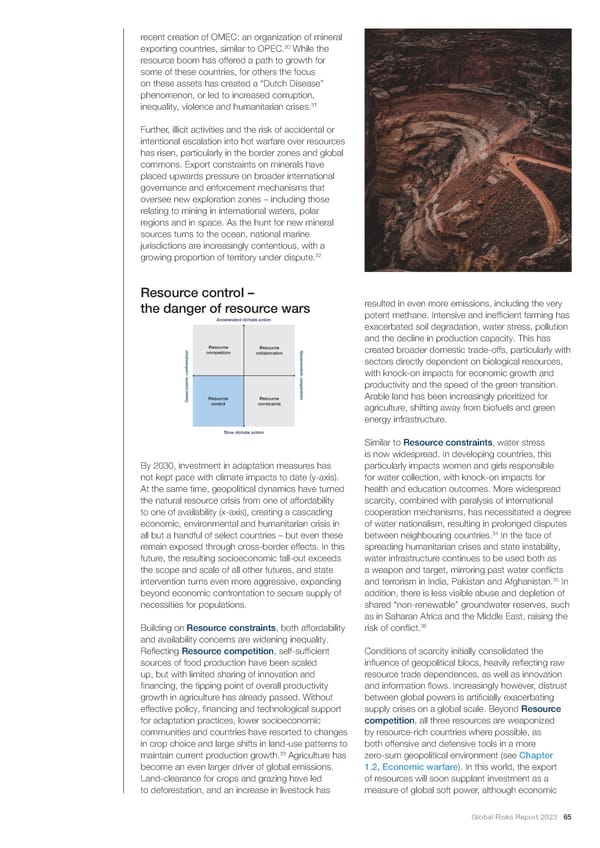recent creation of OMEC: an organization of mineral 30 exporting countries, similar to OPEC. While the resource boom has offered a path to growth for some of these countries, for others the focus on these assets has created a “Dutch Disease” phenomenon, or led to increased corruption, 31 inequality, violence and humanitarian crises. Further, illicit activities and the risk of accidental or intentional escalation into hot warfare over resources has risen, particularly in the border zones and global commons. Export constraints on minerals have placed upwards pressure on broader international governance and enforcement mechanisms that oversee new exploration zones – including those relating to mining in international waters, polar regions and in space. As the hunt for new mineral sources turns to the ocean, national marine jurisdictions are increasingly contentious, with a 32 growing proportion of territory under dispute. Resource control – the danger of resource wars resulted in even more emissions, including the very Accelerated climate action potent methane. Intensive and inef昀椀cient farming has exacerbated soil degradation, water stress, pollution and the decline in production capacity. This has Resource Resource competition collaboration Geoeconomic cooperation created broader domestic trade-offs, particularly with ontation sectors directly dependent on biological resources, with knock-on impacts for economic growth and productivity and the speed of the green transition. Geoeconomic confrResource Resource Arable land has been increasingly prioritized for control constraints agriculture, shifting away from biofuels and green energy infrastructure. Slow climate action Similar to Resource constraints, water stress is now widespread. In developing countries, this By 2030, investment in adaptation measures has particularly impacts women and girls responsible not kept pace with climate impacts to date (y-axis). for water collection, with knock-on impacts for At the same time, geopolitical dynamics have turned health and education outcomes. More widespread the natural resource crisis from one of affordability scarcity, combined with paralysis of international to one of availability (x-axis), creating a cascading cooperation mechanisms, has necessitated a degree economic, environmental and humanitarian crisis in of water nationalism, resulting in prolonged disputes 34 all but a handful of select countries – but even these between neighbouring countries. In the face of remain exposed through cross-border effects. In this spreading humanitarian crises and state instability, future, the resulting socioeconomic fall-out exceeds water infrastructure continues to be used both as the scope and scale of all other futures, and state a weapon and target, mirroring past water con昀氀icts 35 intervention turns even more aggressive, expanding and terrorism in India, Pakistan and Afghanistan. In beyond economic confrontation to secure supply of addition, there is less visible abuse and depletion of necessities for populations. shared “non-renewable” groundwater reserves, such as in Saharan Africa and the Middle East, raising the Building on Resource constraints, both affordability risk of con昀氀ict.36 and availability concerns are widening inequality. Re昀氀ecting Resource competition, self-suf昀椀cient Conditions of scarcity initially consolidated the sources of food production have been scaled in昀氀uence of geopolitical blocs, heavily re昀氀ecting raw up, but with limited sharing of innovation and resource trade dependences, as well as innovation 昀椀nancing, the tipping point of overall productivity and information 昀氀ows. Increasingly however, distrust growth in agriculture has already passed. Without between global powers is arti昀椀cially exacerbating effective policy, 昀椀nancing and technological support supply crises on a global scale. Beyond Resource for adaptation practices, lower socioeconomic competition, all three resources are weaponized communities and countries have resorted to changes by resource-rich countries where possible, as in crop choice and large shifts in land-use patterns to both offensive and defensive tools in a more 33 maintain current production growth. Agriculture has zero-sum geopolitical environment (see Chapter become an even larger driver of global emissions. 1.2, Economic warfare). In this world, the export Land-clearance for crops and grazing have led of resources will soon supplant investment as a to deforestation, and an increase in livestock has measure of global soft power, although economic Global Risks Report 2023 65
 2023 | Global Risks Report Page 64 Page 66
2023 | Global Risks Report Page 64 Page 66